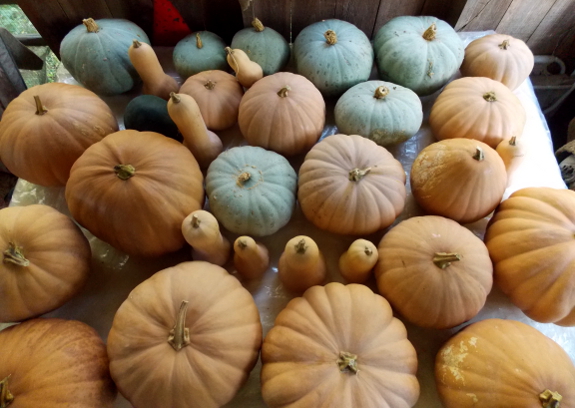
Carol Deppe's garden and diet
 Carol Deppe puts her advice on garden resiliency
to work by growing different staples to feed herself at different times
of the year. Corn and dried beans fill her belly in the spring;
she eats fruit all summer; potatoes, winter squash, and fruit feed her
in the fall; and potatoes and winter
squash are on the menu in the winter. To these garden staples,
Deppe adds duck eggs (and a bit of meat) from
her flock, along with some purchased pastured meat and canned tuna.
Carol Deppe puts her advice on garden resiliency
to work by growing different staples to feed herself at different times
of the year. Corn and dried beans fill her belly in the spring;
she eats fruit all summer; potatoes, winter squash, and fruit feed her
in the fall; and potatoes and winter
squash are on the menu in the winter. To these garden staples,
Deppe adds duck eggs (and a bit of meat) from
her flock, along with some purchased pastured meat and canned tuna.
Deppe's staples are one one of the reasons I didn't get as much out of
her book as I'd hoped to. Although I like the lack of wheat in
Deppe's diet (due to her struggles with celiac's disease), Mark and I
strive for a higher protein diet,
so Deppe's focus on potatoes and other high-carb staples didn't sit
well with me. I also don't really believe in the notion that you
can stay healthy primarily based on supplements, so her use of cod liver
oil to replace most meat in her diet doesn't seem like a nutritious
long-term solution.
On the other hand, I was
intrigued by how well Deppe seems to listen to her body. She notes
that she feels most full after eating foods high in water and fiber,
and she used her own varying hunger levels to discover that she needed
to eat animal-based omega 3s. After noticing that plant-based
sources of omega 3s didn't fulfill her cravings, she did some research
and discovered that only some people are able to turn 18-carbon plant
omega 3s into 20- and
22-carbon animal omega 3s. Perhaps that's why some people crave
meat much more than others do?
| This post is part of our The Resilient Gardener lunchtime series.
Read all of the entries: |
Want more in-depth information? Browse through our books.
Or explore more posts by date or by subject.
About us: Anna Hess and Mark Hamilton spent over a decade living self-sufficiently in the mountains of Virginia before moving north to start over from scratch in the foothills of Ohio. They've experimented with permaculture, no-till gardening, trailersteading, home-based microbusinesses and much more, writing about their adventures in both blogs and books.
Want to be notified when new comments are posted on this page? Click on the RSS button after you add a comment to subscribe to the comment feed, or simply check the box beside "email replies to me" while writing your comment.

If you're really worried about food security/availability, then you really need to include livestock in your plans. While you can survive on a plant based diet, you need meat to thrive, particularly if you work hard or become ill.
Animals have the advantage of being harvestable on your schedule without waiting for MotherNature's schedule. Your whole year's harvest of crops can be wiped out in a day by a nasty hailstorm, etc. In time of prolonged drought, you can keep a few head of livestock watered more easily than irrigating 20 ac of corn & beans.
And if it really comes down to a true SHTF scenario and you need to worry about marauders, you may be able to hide a few steers, chickens or rabbits, but how do you camouflage 20 ac of pumpkins? It's unlikely marauders will try to steal your pasture (unless of course they happen to be from the Fed BLM
I liked Carol's book, though didnt agree with everything. I think my main takeaway was to pay more attention, garden space-wise, to storage crops. Squash are hard to grow here due to our short season, and must be under hoops, which creates difficulties with those that really like to spread. I am trying a coup,e new varieties after reading her book, though. Maybe this year will e better than last.., We are currently plant based eaters. I say "currently" because I have really been craving meat lately.